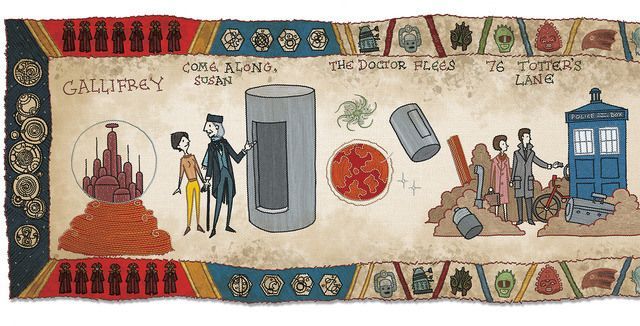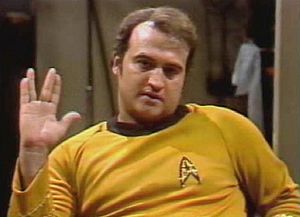(1) THE PAST THROUGH YESTERDAY. Dave Langford recalls his experiences at the Milford (UK) writers workshop three decades ago in “Mr Langford’s Milfords”
My Milford attendance record was nothing to write home about, let alone pad out to a six-volume fantasy trilogy. All “my” Milfords were in the early though not the earliest days at the Compton Hotel, Milford-on-Sea. The Langford era ran from 1977 to 1984, skipping 1979 because that year’s UK Worldcon led to Milford being cancelled, and missing the 1983 event as a personal decision after long and painful study of my credit card statement.
Dave also heartily recommends Christopher Priest’s July post, “The Prequels”:
The misbehaviour of those middle-aged writers at Milford was in fact more or less as described, although I did leave out the bit where one of the most famous writers stormed out in a rage, where two others went for a midnight swim but afterwards couldn’t remember where they’d left their clothes … and when someone suddenly appeared at dinner dressed only in a black plastic bin-liner. No, that was another year.
(2) TYPO IN BRONZE. The Heinlein Society reports a typo was discovered on the dedication plaque of Robert Heinlein’s bust in the Hall of Famous Missourians, and a corrected plaque has now been installed.
(3) CONVERGENCE. Pukeko tries to relate his notions about political reality to Stross’ creation the Laundry Files, and Stross’ own politics, in “The turning is progressing as expected” at Dark Brightness.
The Laundry, on one level, is a horror urban fantasy. On another level, a spy story, And on the third, it has become a satire of the pretensions of the British Civil Service. The British Civil Service still is a good reason to move to than Antipodes.
But there is a tide in the seasons of man, and his neo-liberal political model — which he hates — is becoming one with the Soviet and Tyre. The Luddites he despises are on the flood. And the organisations he writes about, supports, and have his loyalty are converging, which means they are becoming unreliable, without utility, and forked….
Stross and I are of an age. Our youth was the time of Thatcher, Gorbachev, Clinton and brush wars in failing states. Our leaders became neo conservatives, including the converged leftist ones, and broke the social contract of the welfare state. We remember the welfare state. And we remember the Christmas strikes.
But that world has gone, along with the rules that made our society decent, functional, and allowed us to align with those who did not have the same religion, politics or lifestyle. The current social justice cadre instead demand we all double down and quackspeak.
My fear is that Stross will do this. I would much rather he pull the plot off, as he did when he introduced vampirism into the world. He moved too far into the uncanny valley with the last book. I want his cynical, but believable, Bob back. He is too good a writer to quack. And he does not deserve to go down with this death dealing elite.
(4) KEEP THAT RED NOSE UNDER COVER. McDonald’s downplays Ronald McDonald while ‘creepy clown’ sightings spread, reports the Los Angeles Times.
(5) SPACE TOURISM. Carl Slaughter points out —
Hidden Universe Travel Guides: Star Trek: Vulcan
by Star Trek novelist Dayton Ward
Plan your next trip to the planet Vulcan! Find restaurants that serve the best fried sandworms and Vulcan port. Take a trip to the Fire Plains or experience spring break at the Voroth Sea. Learn all about the native Vulcan people and their unusual customs. Discover how to correctly perform the traditional Vulcan salutation (you really don’t want to get this wrong). Learn key Vulcan phrases such as Nam-tor puyan-tvi-shal wilat: “Where is your restroom?” Find out what to do if you suddenly find yourself host to a katra—a Vulcan’s living spirit—at an inconvenient moment. All this and more can be found within the pages of this essential travel guide to one of the most popular—and logical—destinations in the known universe.
This Hidden Universe travel guide draws on 50 years of Star Trek TV shows, films, and novels to present a comprehensive guide to Spock’s iconic home world. Modeled after real-world travel guides, the book will explore every significant region on Vulcan with fascinating historical, geographical, and cultural insights that bring the planet to life like never before. Also featuring a dynamic mixture of classic Star Trek imagery and original illustrations created exclusively for the book, Hidden Universe Travel Guide: Star Trek: Vulcan is the perfect way to celebrate 50 years of Star Trek and will thrill pop culture fans and hardcore Star Trek fans alike.
(6) HOLD ON TO THE LIGHT. Cat Rambo has posted her contribution to the HoldOnToTheLight campaign, “Nattering Social Justice Cook: Be Kind to Yourself”.
I’ve found that writers excel at angst and guilt, at worrying at 2 am over whether or not they stuck their foot in their mouth (human nature being what it is, the answer is sometimes yes), at being anxious and projecting futures far out of proportion to actuality in their horror.
They’re also tough on themselves, holding themselves to sometimes impossible standards. It involves being willing to forgive yourself and the illness you live with, to not just know yourself but be comfortable with yourself.
(7) IN THE BEGINNING. EverydayFangirl interviewed Lois McMaster Bujold on her early fannish life:
When do you realize you were a Fangirl?
LMB:
Before the term “fangirl” was invented. I started reading science fiction for grownups at about age nine, because my father, an engineering professor, used to buy the magazines and books to read on the plane when he went on consulting trips, and they fell to me. Got my first subscription to Analog Magazine at age 13. So when Star Trek came along in 1966, when I was in high school, the seed fell on already-fertile ground; it was an addition, not a revelation. At last, SF on TV that was almost as good as what I was reading, a miracle! I would have just called myself a fan then, or a reader, ungendered terms I note.
In my entire high school of 1,800 students, there was only one other genre reader I knew of (later we expanded to 4 or 6), my best friend Lillian, and she only because we traded interests; I got history from her, she got F&SF from me. So there was no one to be fans with, for the first while.
(8) GHOST OF HALLOWEENS PAST. The Los Angeles Times invites readers to “See what’s killing haunted houses and other independent Halloween attractions”
For every success like Carbone’s, there are several mom-and-pop haunted attractions that have been killed off by mounting insurance and other expenses, as well as extensive government regulations…
“It’s getting so expensive that unless you have $100,000 to put into it and $30,000 into the marketing, you are not going to make it,” said Jeff Schiefelbein, chief executive of Sinister Pointe Productions, and Orange County company that builds haunted attractions for theme parks and individual entrepreneurs.
(9) KAIJU IN THEATERS THIS WEEK. Shin Godzilla, the latest addition to the mythos, is having a limited theatrical run with subtitles right now in the US and Canada.
Make way for the ultimate homage to one of the most enduring legends of the big screen—Godzilla! The King of the Monsters is back in Tokyo for a city-crushing crusade that speaks to the very roots of the world-renowned franchise.
It’s a peaceful day in Japan when a strange fountain of water erupts in the bay, causing panic to spread among government officials. At first, they suspect only volcanic activity, but one young executive dares to wonder if it may be something different… something alive. His worst nightmare comes to life when a massive, gilled monster emerges from the deep and begins tearing through the city, leaving nothing but destruction in its wake. As the government scrambles to save the citizens, a rag-tag team of volunteers cuts through a web of red tape to uncover the monster’s weakness and its mysterious ties to a foreign superpower. But time is not on their side—the greatest catastrophe to ever befall the world is about to evolve right before their very eyes.
(10) UNDERRATING INDIES. Amanda S. Green gives a Passive Voice columnist a stern talking to about his short-selling indie authors in “Oh my, are they protesting too much” at Mad Genius Club.
Yesterday, when I started looking for something to blog about, I made my way over to The Passive Voice. TPV is an excellent source of information for every author out there, traditionally published or indie. One post in particular caught my eye. It asks the question we have heard asked so many times over the last few years: Are self-published books inferior to professionally published books?
Now, without even reading the article, I knew I wasn’t going to like the post TPV had linked to. The title of the article itself shows a bias, not by TPV but by the author of the article TPV linked to. It assumes that self-published books, what we call indies, aren’t professionally published. Take that one step further. By phrasing the headline the way it did, the author of the article signals from the beginning that indies aren’t as professional or as good as traditionally published books. Otherwise, why not rephrase the title of the article as “are self-published books inferior to traditionally published books?”
So, without even reading the underlying article, my back is up. I can’t speak for anyone except myself but I am a professional writer. I make money from writing, enough to pay my bills. I simply chose not to take the traditional publishing route. That does not make me any less of a professional than any other writer who has chosen to try to find an agent, get a contract and publish with one of the Big 5 publishers.
(11) ALL OVER BUT THE SHOUTING. Jim C. Hines adds his observations about the Weingart/Worldcon 75 controversy.
The Beale Effect: I’m bemused at how effectively Theodore Beale managed to unite Worldcon and Weingart, both of whom came together as if to say, “Oh hell no. F**k that guy.” As soon as Beale jumped in, Weingart pulled his posts, Worldcon called Weingart to apologize, then posted their public apology. It pretty much ended the public dispute right there.
Tuesday-Afternoon Quarterbacking: I wasn’t there, and I wasn’t part of the decision-making process. But as I understand it, Weingart notified the staff from the beginning that the other individual had set boundaries about not wanting to interact or work with him. Bringing Weingart on but restricting his interactions seems like a solution destined to cause problems. If this other individual was already working for the con, my hindsight solution would be to simply not bring Weingart on staff. Yeah, it might mean losing a good volunteer in Weingart, but it would have more effectively respected the other individual’s boundaries, and would have avoided the mess that eventually followed.
(12) PLUTO’S NEW PAL ISN’T GOOFY. The discovery-by-software of another dwarf planet: “A Friend For Pluto: Astronomers Find New Dwarf Planet In Our Solar System”.
Scientists in Michigan have found a new dwarf planet in our solar system.
It’s about 330 miles across and some 8.5 billion miles from the sun. It takes 1,100 years to complete one orbit.
But one of the most interesting things about the new object, known for the time being as 2014 UZ224, is the way astronomers found it.
David Gerdes of the University of Michigan led the team that found the new dwarf planet. Gerdes describes himself as “an adult-onset astronomer,” having started his scientific career as a particle physicist.
He helped develop a special camera called the Dark Energy Camera that the U.S. Department of Energy commissioned to make a map of distant galaxies.
A few years ago, Gerdes had some undergraduates visiting him for the summer. He decided to give them a project: He asked them if they could find some solar system objects lurking in the galaxy map.
Chip Hitchcock joked, “Clyde Tombaugh is spinning in his grave and grumbling ‘You punks don’t know how easy you have it these days!’”
(13) X MARKS THE SPOTS. “Why Are There X’s In The Desert?” In the first place, you probably never knew there were. But for the high-tech answer, you need to search back to the Cold War.
We step out in the searing heat and into a desolate landscape — just cactus and tumbleweed.
“Middle of nowhere,” Penson says.
We walk toward the base of a small mountain range, and that’s when we see it: four 25-foot slabs of concrete inlaid in the desert floor that form a giant “X.”
Penson kneels down to brush off the sand covering a tarnished brass plate at the very center. The engraving reads: “$250 fine or imprisonment for disturbing this marker — Corps of Engineers – U.S. Army.”
That’s who Penson and Owen contacted to get their answer.
These X’s were once part of a top-secret government program called CORONA — the nation’s first reconnaissance satellite program.
[Thanks to Chip Hitchcock, Cat Rambo, John King Tarpinian, Mark-kitteh and Petréa Mitchell for some of these stories. Title credit goes to File 770 contributing editor of the day Heather Rose Jones.]














